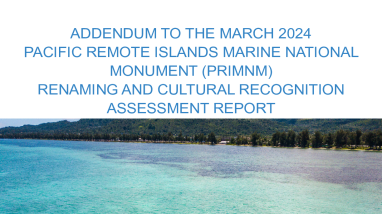The purpose of this addendum is to summarize the engagement events hosted by the U.S. Fish and Wildlife Service (USFWS), the National Center for Environmental Conflict Resolution (the National Center), and the National Oceanic and Atmospheric Administration (NOAA)1 following the release of the March 2024 Pacific Remote Islands Marine National Monument (PRIMNM) Renaming and Cultural Recognition Assessment Report. Engagements were planned to ensure:
• A high degree of inter- and intra-agency coordination.
• The highest practical degree of collaboration with interested individuals and groups including Indigenous cultural practitioners, voyagers, and other “representatives from Indigenous Peoples with ancestral, historical, and cultural connections to the area2” to determine a new name for the Monument and places within.
• Robust dialog amongst the parties mentioned above including individuals who participated in this assessment to the degree possible.
• Transparency and clarification around how a new name could be determined, including the process laid out in the Presidential Memorandum.3
Publication date
Facility
Media Usage Rights/License
Public Domain
Program
FWS and DOI Region(s)


